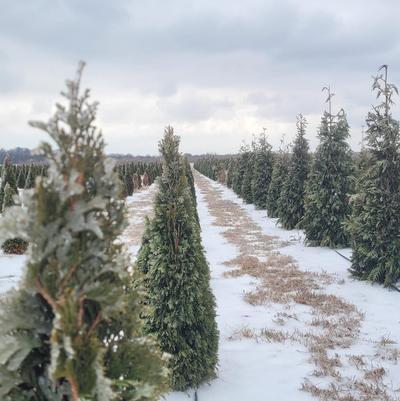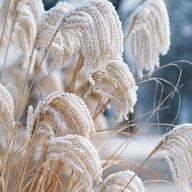Nectar Plants for Migrating Pollinators
A hot topic in conservation these days is Connectivity - how to alleviate the habitat fragmentation that threatens the livelihood of wildlife. Gardeners can become part of the solution by ensuring that migrating pollinators have food sources along their way.

This time of year, around September, threats facing migratory wildlife are more on our minds. The flyway corridors that migratory pollinators use have been diminished and fragmented by development, pesticides and exotic (non-native) plant invasion. This affects certain bird species, especially hummingbirds, some bat species, and most butterflies. A hot topic in conservation these days is Connectivity - how to alleviate the habitat fragmentation that threatens the livelihood of wildlife. Gardeners can become part of the solution by ensuring that migrating pollinators have food sources along their way.
Plant Preferences
In general, plants that produce nectar in late summer and fall and are important food sources that will help sustain our North American pollinators through their migrations. However, different types of pollinators generally prefer different types of plants.
Therefore, we have plants organized into groups preferred by butterflies, hummingbirds and bats. The US Hardiness Zones are listed after the plant name to help facilitate selecting ones that will thrive in your landscape.
Butterflies
Flowers that butterflies visit are usually born in clusters and provide landing platforms, are often brightly colored, open during the day and have nectar guides, a region of low ultraviolet reflection near the center of the flower to guide the insect toward the nectar.
These plants can fuel Monarch and other migrating butterflies:
Native milkweeds (generally 4-9), Tropical Milkweed (Asclepias curassavica) (9-11), Goldenrods (2-8), Spirea (most 4-8), Ironweed (4-8), Asters (any native to your area), Liatris (most 5-9), Joe Pye Weed (4-8), Sedums (most 3-9, a few can take even colder areas), native Helianthus Sunflowers (most 4-8), Zinnia (2-11), Lantana (8-11), Pentas (9-11), Cosmos (perennial in 9-10, annual elsewhere), Petunias (perennial in 9-11, annual elsewhere), Agastache (4-10), Bottlebrush (Callistemon) (7-10), Butterfly Bush (Buddleia) (5-9 or 8-10 depending on variety), Cardinal Flower (3-9), Lollipop Verbena (Verbena bonariensis) (7-11), Mexican Sunflower (Tithonia rotundifolia) (2-11), Passion Vine (Passiflora) (most varieties 6-10), both Red (8-11) and Blue (9-11) Porterweed (Stachytarpheta), Salvia ‘Black and Blue’ (Salvia guaranitica) (8-10), Frostweed (Verbesina virginica) (6-10), late-flowering Boneset (Eupatorium serotinum) (4-8), Duranta (10-11), Golden Alexander (4-8), Rattlesnake Master (5-9), Stiff Coreopsis (3-8), Purple Prairie Clover (3-8), Culver’s Root (3-8), and Purple Coneflower (4-10). Decomposing fruit and berries that fall in late summer and fall can also provide food for migrating butterflies.
Hummingbirds
Birds that pollinate generally visit flowers that are tubular or have funnels or cups, with petals that are recurved out of the way, strong supports for perching, bright coloration, and are odorless and open during the day.
You’ll notice that many of the same plants that fuel butterflies are also used by hummingbirds. Again, these are important late-season bloomers:
Native milkweeds (generally 4-9), Tropical Milkweed (Asclepias curassavica) (9-11), Agastache (4-10), Zinnia (2-11), Bottlebrush (Callistemon) (7-10), Butterfly Bush (Buddleia) (5-9 or 8-10 dep on variety), Cardinal Flower (3-9), Lollipop Verbena (Verbena bonariensis) (7-11), Mexican Sunflower (Tithonia rotundifolia) (2-11), Passion Vine (Passiflora) (most varieties 6-10), both Red (8-11) and Blue (9-11) Porterweed (Stachytarpheta), beebalm (Monarda) (3-9), Cape Honeysuckle (Tecoma capensis) (9-11), Firebush (Hamelia) (9-11), Firespike (Odontonema) (8-11), Jacobinia (Justicia carnea) (8-11), Lantana (8-11), Powderpuff (Calliandra) (9-11), Salvia ‘Black and Blue’ (Salvia guaranitica) (8-10), many additional salvias including scarlet sage (Salvia splendens) (10-11), Salvia greggii (5-9), Salvia pachyphylla (5-9), Mexican Bush Sage (Salvia leucantha) (8-10) and Wendy’s Wish Salvia (9-11), Shrimp Plant (Justicia brandegeana) (9-11), Tropical Hibiscus (9-11), Trumpet Creeper (Campsis radicans) (4-10), Yellow Bells (Tecoma stans) (9-11), Oleander (8-10), Rose of Sharon (Hibiscus syriacus) (5-8), Gladiolus (most varieties 7-10), late summer-blooming Daylily (Hemerocallis fulva) (3-9), Scrophularia (4-9), Bat-faced Cuphea (9-12), and Tree Tobacco (Nicotiana glauca) (7-10).
Bats
Flowers that bat pollinators visit are typically large in size (1 to 3.5 inches), open at night when they also emit a fragrance or odor, and pale or white in color. The flower may also point downward to accommodate the flight of the bat.
East Coast bats that migrate are insectivorous, but 3 species of bats in the western U.S. migrate significant distances to the neotropics and are nectar feeders. Westerners can plant these plants to support them:
Guava (9-12), Banana (9-10), Cacao (Cocoa) (11-12), Mango (10-11), Fig (8-10, a few cold hardy in 6-7), Date Palm (9-11), Cashew Tree (9-11), Night-blooming Phlox (9-11), Evening Primrose (4-9), Fleabane (2-7 or 3-8, depending on species), Moonflower (10-12), Goldenrod (2-8), Nicotiana (9-11), Four O’clocks (7-10), Datura (8-10), Yucca (most species within 7-10, some hardy to 3), Night-blooming Jessamine (9-11), Cleome (basically an annual but may overwinter in 10-11), French marigolds (perennial in 8-10, annual in all zones), Organ pipe Cactus (9-11), Saguaro Cactus (8-11), and Century Plant (Agave) (8-10).
You can Make a Difference
Gardeners can have a positive impact on pollinator survival simply by planting some nectar-rich perennials in our landscapes, especially those that flower in the late summer and fall. By also practicing organic gardening methods and eliminating or at least properly timing the use of only limited chemical pesticides, we can potentially play a significant role in the rise of pollinator populations.

